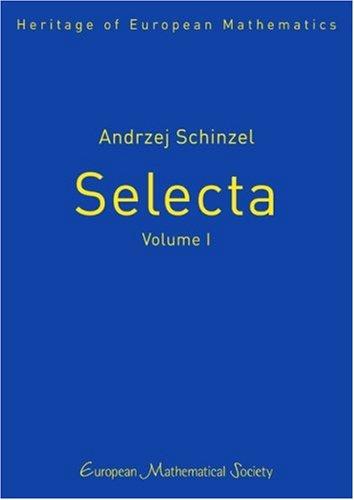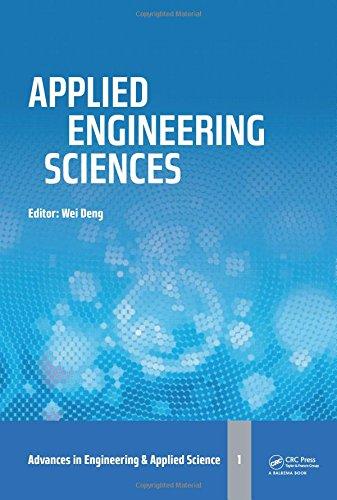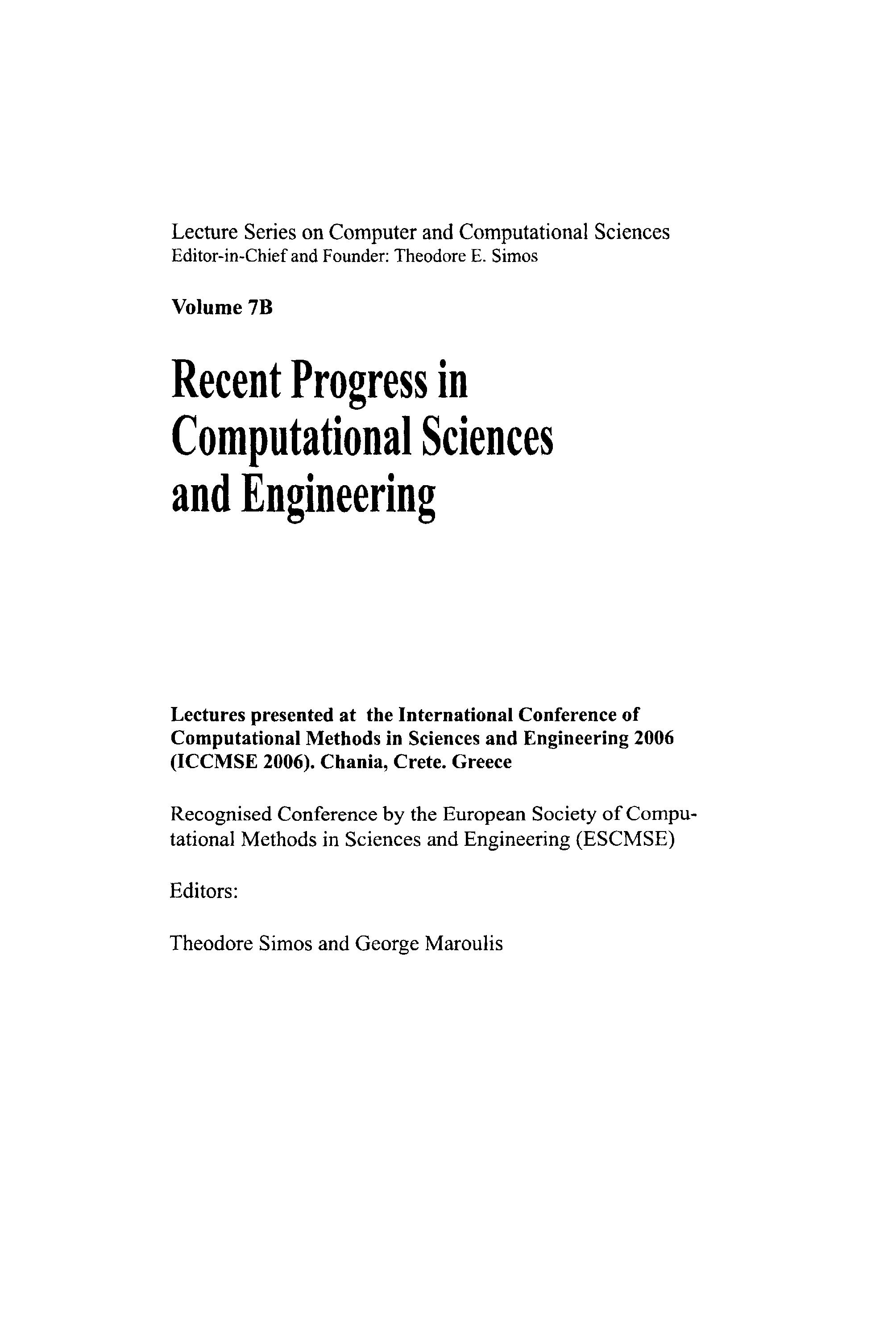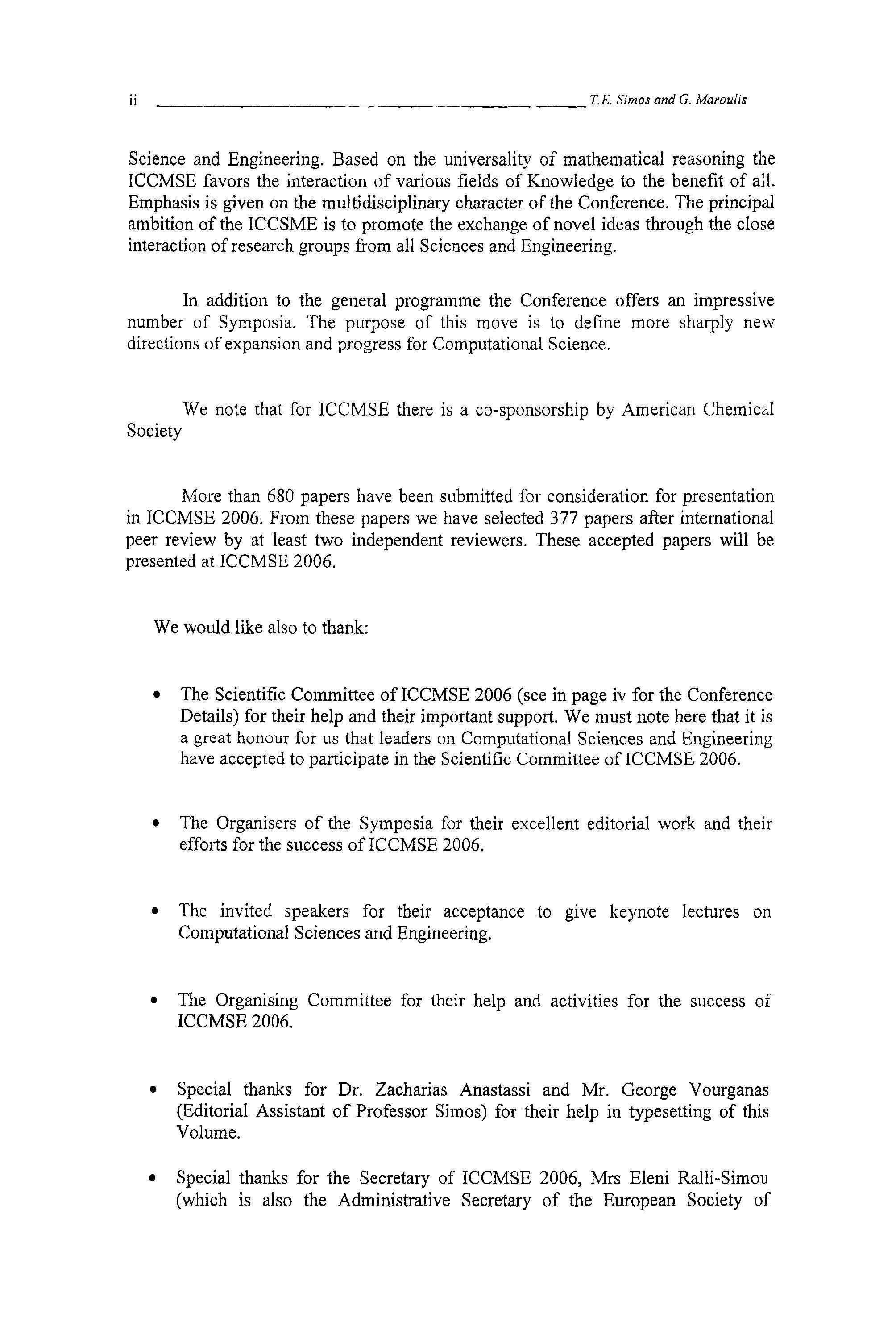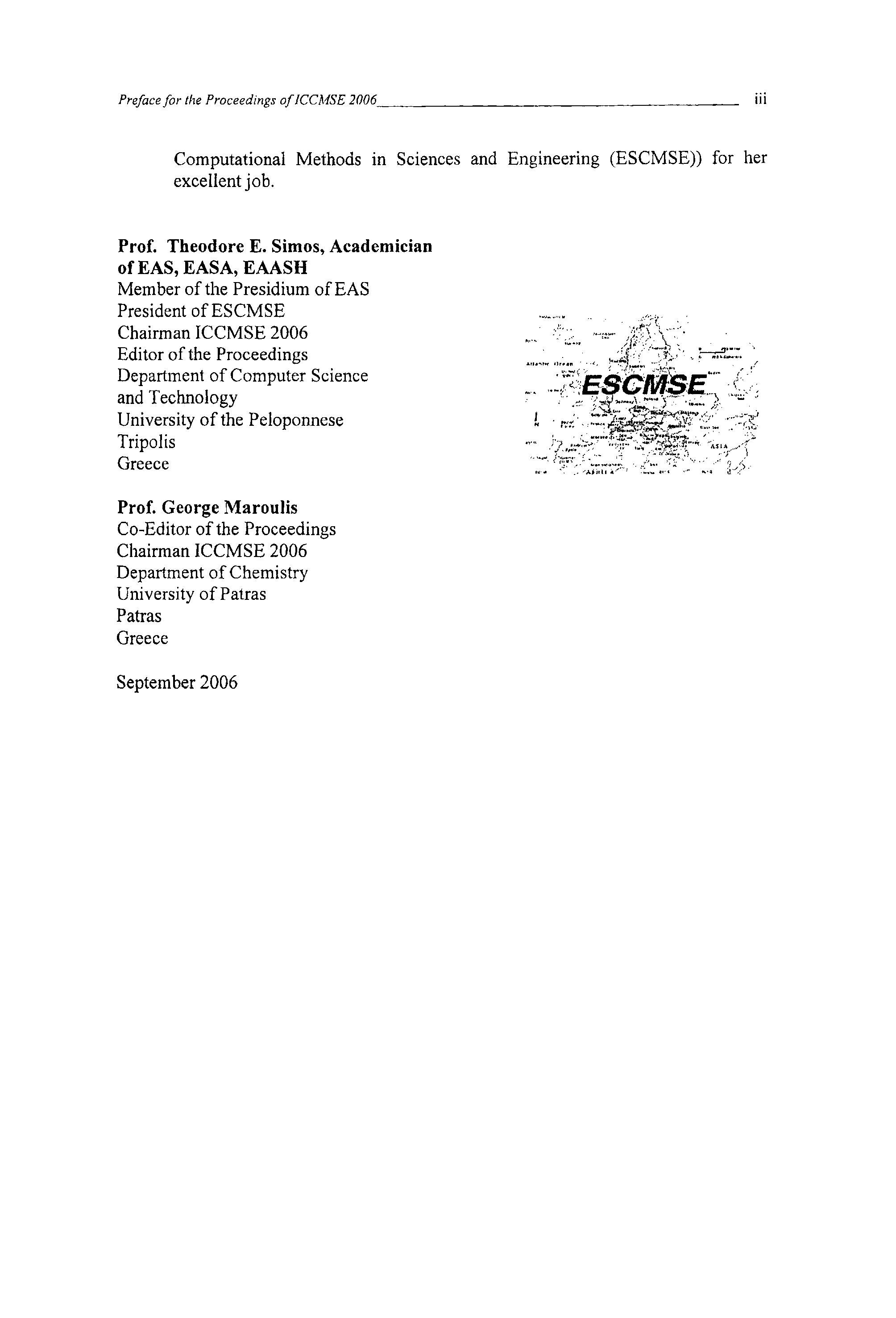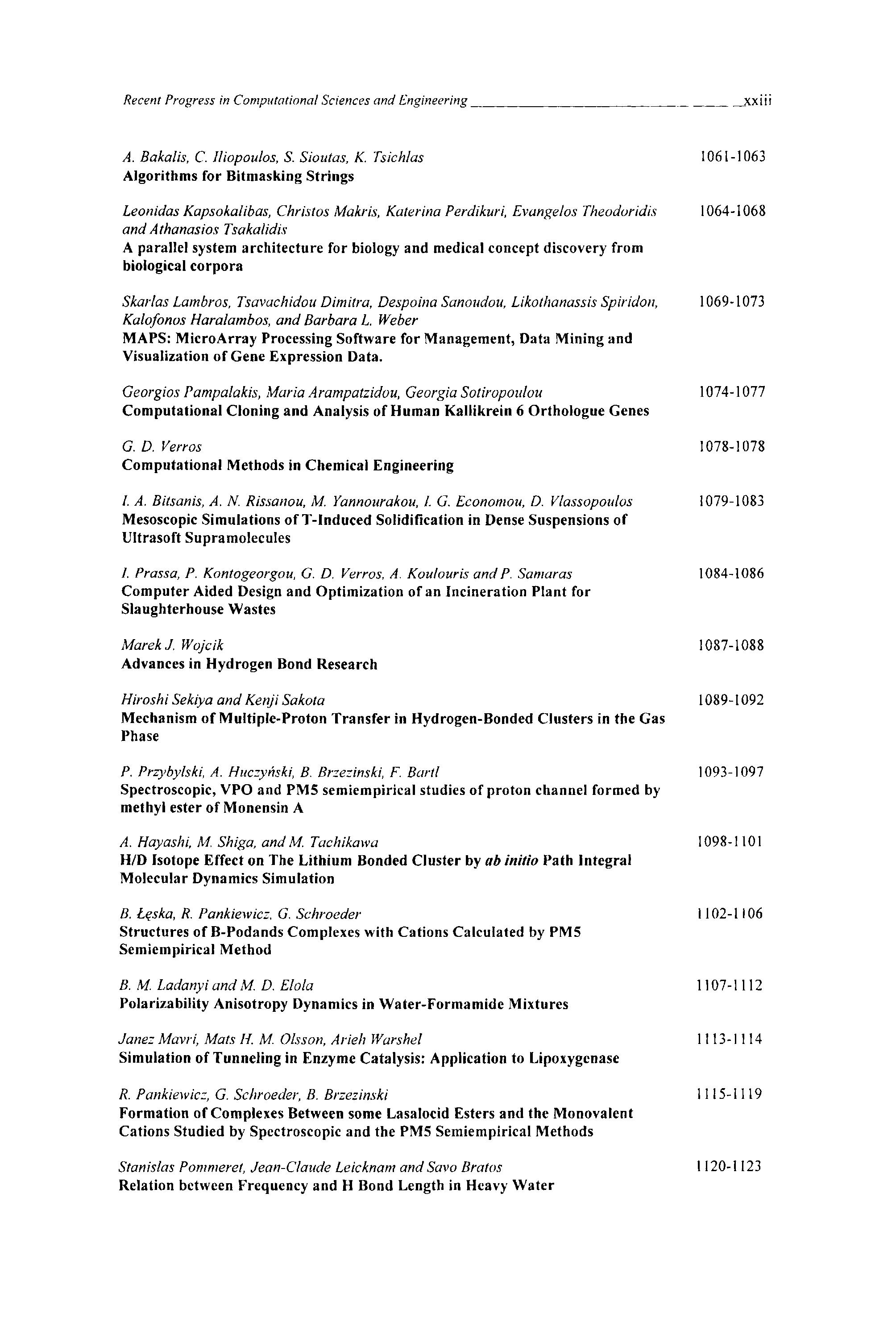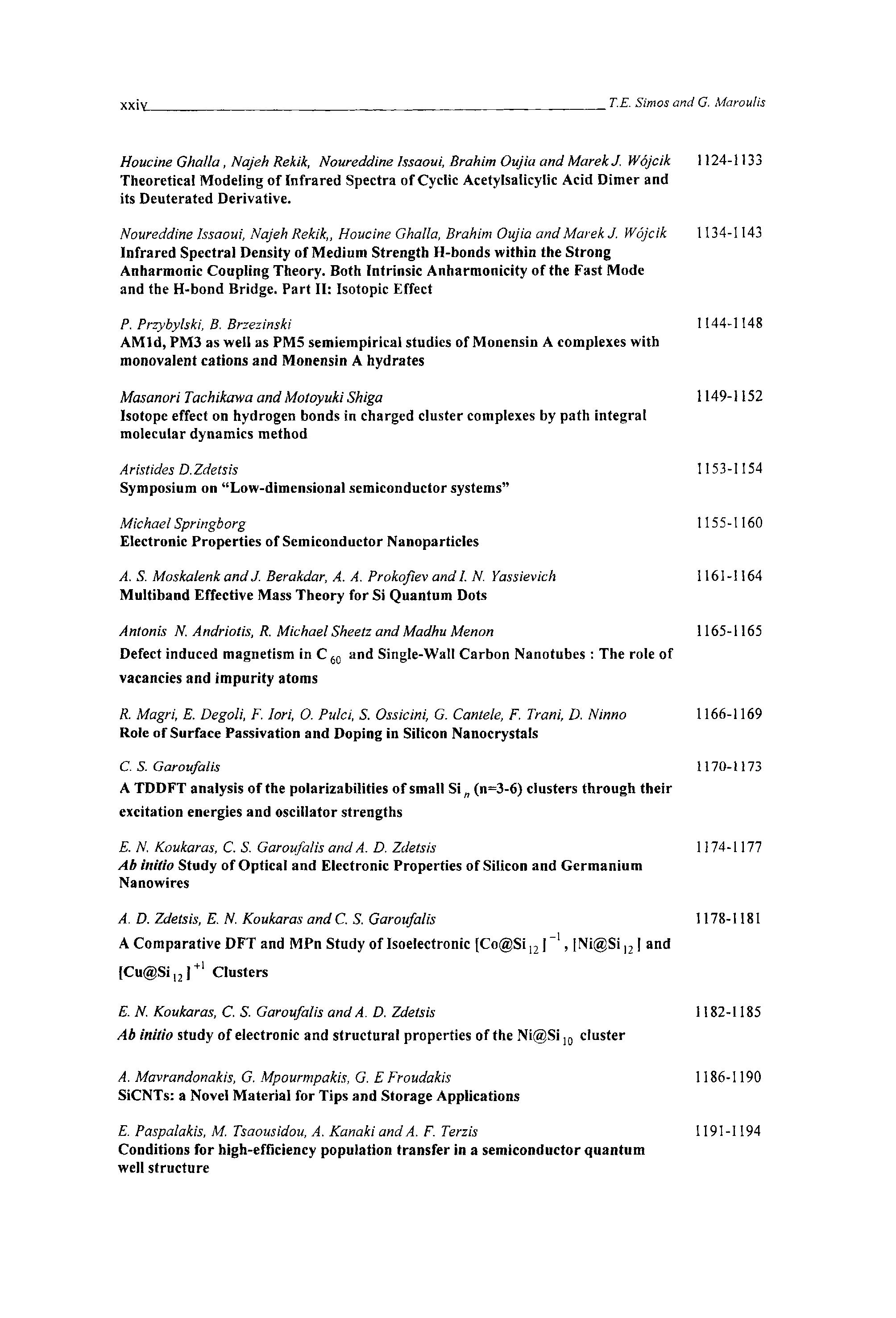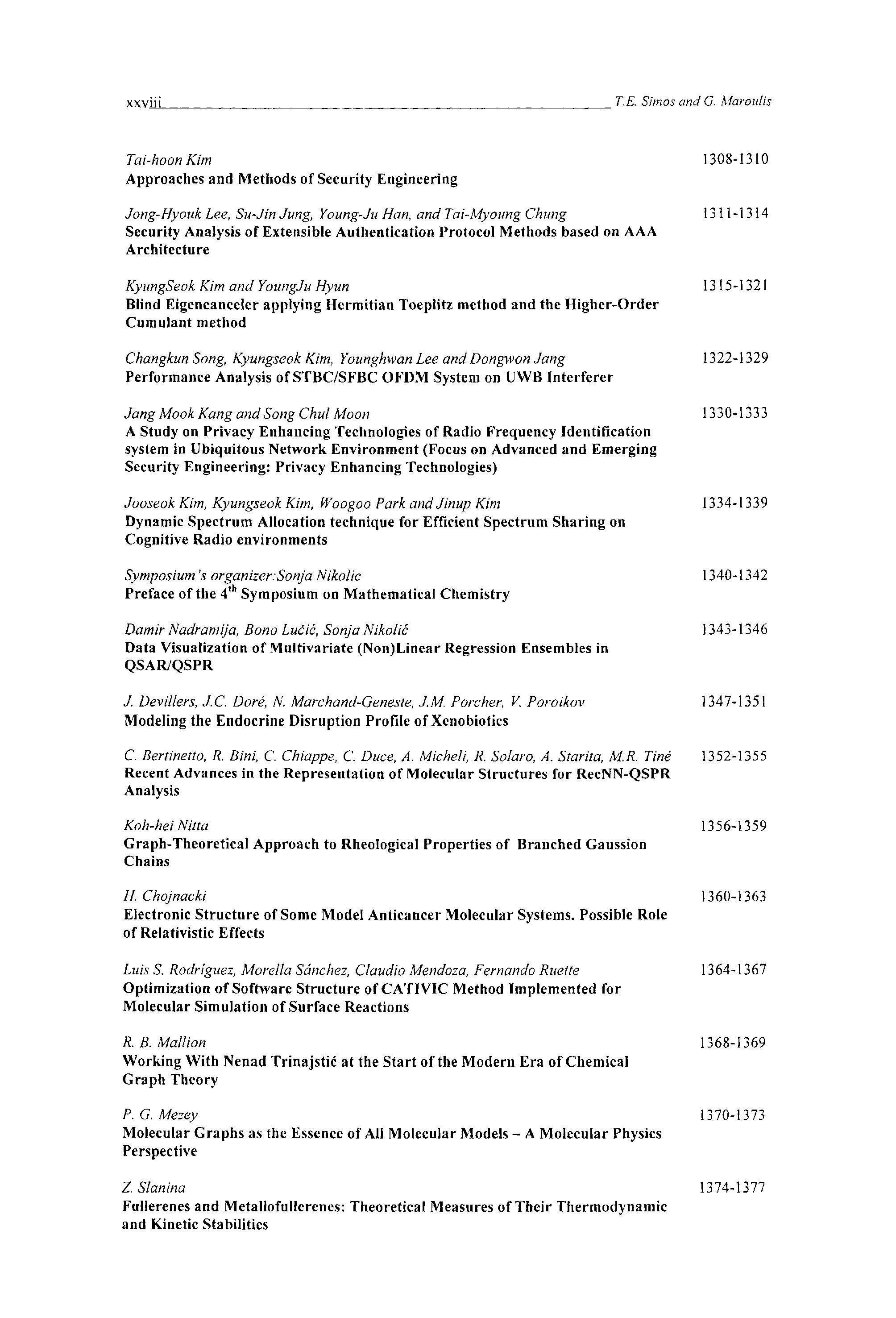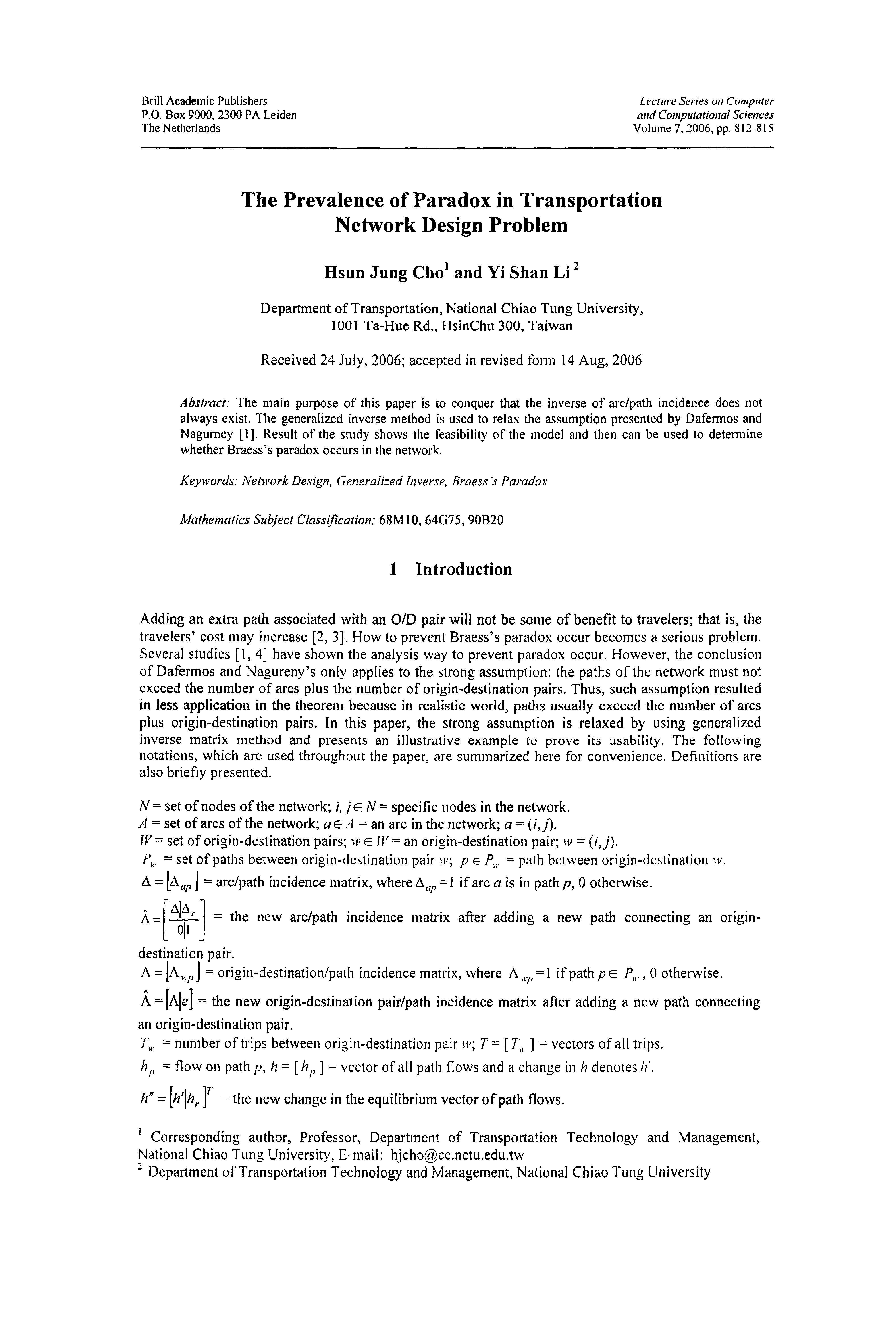Recent Progress in Computational Sciences and Engineering
Lectures presented at the International Conference of Computational Methods in Sciences and Engineering 2006 (ICCMSE 2006). Chania, Crete. Greece
Recognised Conference by the European Society of Computational Methods in Sciences and Engineering (ESCMSE)
Editors:
Theodore Simos and George Maroulis
CRC Press
Taylor & Francis Group
6000 Broken Sound Parkway NW, Suite 300
Boca Raton, FL 33487-2742
© 2006 by Koninklijke Brill NV Leiden The Netherlands
CRC Press is an imprint of Taylor & Francis Group, an Informa business
No claim to original U.S. Government works Version Date: 20120522
International Standard Book Number-13: 978-1-4665-6451-0 (eBook - PDF)
This book contains information obtained from authentic and highly regarded sources. Reasonable efforts have been made to publish reliable data and information, but the author and publisher cannot assume responsibility for the validity of all materials or the consequences of their use. The authors and publishers have attempted to trace the copyright holders of all material reproduced in this publication and apologize to copyright holders if permission to publish in this form has not been obtained. If any copyright material has not been acknowledged please write and let us know so we may rectify in any future reprint.
Except as permitted under U.S. Copyright Law, no part of this book may be reprinted, reproduced, transmitted, or utilized in any form by any electronic, mechanical, or other means, now known or hereafter invented, including photocopying, microfilming, and recording, or in any information storage or retrieval system, without written permission from the publishers.
For permission to photocopy or use material electronically from this work, please access www.copyright.com (http://www.copyright.com/) or contact the Copyright Clearance Center, Inc. (CCC), 222 Rosewood Drive, Danvers, MA 01923, 978-750-8400. CCC is a not-for-profit organization that provides licenses and registration for a variety of users. For organizations that have been granted a photocopy license by the CCC, a separate system of payment has been arranged.
Trademark Notice: Product or corporate names may be trademarks or registered trademarks, and are used only for identification and explanation without intent to infringe.
Visit the Taylor & Francis Web site at http://www.taylorandfrancis.com
and the CRC Press Web site at http://www.crcpress.com
Lecture Series on Computer and Conrputaliona/ Sciences Volume 7, 2006, pp. i-iii
Preface
Recent Progress in Computational Sciences and Engineering (Proceedings of the International Conference of Computational Methods in Sciences and Engineering 2006) (ICCMSE 2006)
Recognised Conference by the European Society of Computational Methods in Sciences and Engineering (ESCMSE)
The International Conforence of Computational Methods in Sciences and Engineering 2006 (ICCMSE 2006) is taken place at the Hotel PANORAMA, Chania, Crete, Greece between 27th October and 1st November 2006.
The aim of the conference is to bring together computational scientists from several disciplines in order to share methods and ideas.
Topics of general interest are:
Computational Mathematics, Theoretical Physics and Theoretical Chemistry. Computational Engineering and Mechanics, Computational Biology and Medicine, Computational Geosciences and Meteorology, Computational Economics and Finance, Scientific Computation. High Performance Computing, Parallel and Distributed Computing, Visualization, Problem Solving Environments, Numerical Algorithms, Modelling and Simulation of Complex System, Web-based Simulation and Computing, Grid-based Simulation and Computing, Fuzzy Logic, Hybrid Computational Methods, Data Mining, Information Retrieval and Virtual Reality, Reliable Computing, Image Processing, Computational Science and Education etc.
The International Conference of Computational Methods in Sciences and Engineering (ICCMSE) is unique in its kind. It regroups original contributions from all fields of the traditional Sciences, Mathematics, Physics, Chemistry, Biology, Medicine and all branches of Engineering. It would be perhaps more appropriate to define the ICCMSE as a Conference on Computational Science and its applications to
T.E. Simos and G. Maroulis
Science and Engineering. Based on the universality of mathematical reasoning the ICCMSE favors the interaction of various fields of Knowledge to the benefit of all. Emphasis is given on the multidisciplinary character of the Conference. The principal ambition of the ICCSME is to promote the exchange of novel ideas through the close interaction of research groups from all Sciences and Engineering.
In addition to the general programme the Conference offers an impressive number of Symposia. The purpose of this move is to define more sharply new directions of expansion and progress for Computational Science.
We note that for ICCMSE there is a co-sponsorship by American Chemical Society
More than 680 papers have been submitted for consideration for presentation in ICCMSE 2006. From these papers we have selected 377 papers after international peer review by at least two independent reviewers. These accepted papers will be presented at ICCMSE 2006.
We would like also to thank:
• The Scientific Committee ofiCCMSE 2006 (see in page iv for the Conference Details) for their help and their important support. We must note here that it is a great honour for us that leaders on Computational Sciences and Engineering have accepted to participate in the Scientific Committee ofiCCMSE 2006.
• The Organisers of the Symposia for their excellent editorial work and their efforts for the success of ICCMSE 2006.
• The invited speakers for their acceptance to give keynote lectures on Computational Sciences and Engineering.
• The Organising Committee for their help and activities for the success of ICCMSE 2006.
• Special thanks for Dr. Zacharias Anastassi and Mr. George Vourganas (Editorial Assistant of Professor Simos) for their help in typesetting of this Volume.
• Special thanks for the Secretary of ICCMSE 2006, Mrs Eleni Ralli-Simou (which is also the Administrative Secretary of the European Society of
Computational Methods in Sciences and Engineering (ESCMSE)) for her excellent job.
Prof. Theodore E. Simos, Academician of EAS, EASA, EAASH Member of the Presidium of EAS President of ESCMSE Chairman ICCMSE 2006 Editor of the Proceedings Department of Computer Science and Technology University ofthe Peloponnese Tripolis
Greece
Prof. George Maroulis Co-Editor of the Proceedings Chairman ICCMSE 2006 Department of Chemistry University ofPatras Patras
Greece
September 2006
Conference Details
International Conference of Computational Methods in Sciences and Engineering 2006 (ICCMSE 2006), Hotel PANORAMA, Chania, Crete, Greece, 27 October -1 November, 2006.
Recognised Conference by the European Society of Computational Methods in Sciences and Engineering (ESCMSE)
Chairmen and Organizers
Professor Theodore E. Simos, Academician of EAS, EASA, EAASH, Member of the Presidium of EAS, President of ESCMSE, Department of Computer Science and Technology, University of the Peloponnese, Tripolis
Professor George Maroulis, Department of Chemistry, University of Patras, Patras, Greece
Scientific Committee
Dr. B. Champagne, Universite de Namur, Belgique
Prof. S. Farantos, University of Crete, Greece
Prof. I. Gutman, University ofKragujevac, Serbia
Prof. Hans Herrmann, University of Stuttgart, Germany
Prof. P.Mezey, Memorial University of Newfoundland, Canada
Prof. C. Pouchan, Universite de Pau, France
Dr. G. Psihoyios, Vice-President ESCMSE
Prof. B. M. Rode, University oflnnsbruck, Austria
Prof. A. J. Thakkar, University of New Brunswick, Canada
Special Lecture
Rudolph A. Marcus, Nobel Prize in Chemistry 1992, Arthur Amos Noyes
Professor of Chemistry, California Institute of Technology, USA
Highlighted Lectures:
A.D. Buckingham, University of Cambridge, UK
Bjorn 0. Roos, University of Lund, Sweden
Werner Kutzelnigg, University ofBochum, Germany
Invited Speakers
Tadeusz Bancewicz, Poland.
Sylvia Canuto, Brazil. Minhaeng Cho, Korea
James R. Chelikowsky, USA.
C. Cramer, USA.
M. Heaven, USA. Hans Herrmann, Germany.
A. Hinchliffe, UK.
K. Hirao, Japan.
Julius Jellinek, USA
P. Denmark.
Ilya Kaplan, Mexico
B.Ladanyi, USA
J. Leszczynski, USA.
Paul G. Mezey, Canada
M. Nakano, Japan.
P. Pyykko, Finland.
J. Sauer, Germany.
H.F. Schaefer, USA.
N S Scott, UK
M. Urban, Slovakia
K. Yamaguchi, Japan.
Organizing Committee
Mrs Eleni Ralli-Simou (Secretary of ICCMSE 2006)
Mr. D. Sakas
Mr. Z. A. Anastassi
Mr. T.V. Triantafyllidis
Mr. G. Vourganas
Mr. Th. Monovasilis
Constantinos Makris
Table of Contents
International Symposium on Computational Electronics and Selected Topics
Physical Modeling, Mathematical Theory and Numerical Algorithm
Hsun Jung Cho and Yi Shan Li
The Prevalence of Paradox in Transportation Network Design Problem
Yiming Li and Shao-Ming Yu
A Unified Optimization Framework for Real World Problems
N. Konofaos, D. Ntalaperas
Simulation of the single qubit Phase operation in an ionized P 2 donor molecule implanted on S i semiconductor material
Hsun-Jung Cho and Yu-Kuang Chen
An Improved Efficiency of the Frank-Wolfe Algorithm for Network Traffic
Assignment
L. Cherfi
A New Riccati Type Algorithm for Coupled Algebraic MCV Riccati Equations
Yow-Jen Jou, Wan-Ru Chang, Chien-Lun Lan
Statistical Estimation of Dynamic Tobit Models
Yow-Jen Jou, Hsun-Jung Cho, Chien-Lun Lan, Chia-Chun Hsu
Parallel Chain Convergence of Time Dependent Origin-Destination Matrices with Gibbs Sampler
Yiming Li
Electron Energy State Spin Splitting in Nanoscale InAs/GaAs Semiconductor Quantum Rings
Peter Schwerdtfeger
Relativistic Quantum Theory: Computational Perspectives and Applications
B. Assadollahzadeh, S. Schafer, P. Schwerdtfeger
Polarizabilities of Medium-Sized Tin Clusters (Sn 10 -Sn 18 ): A DFT Study
Radovan Bast, Trond Saue, Peter Schwerdtfeger
Parity Non-Conservation and NMR Observables within the 4-Component Relativistic Framework
L. Belpassi, F. Tarantelli, A. Sgamellotti, H. M Quiney
Computational strategies based on electron density fitting in relativistic density functional theory
Robert Berger and Jason L. Stuber
Electroweak Quantum Chemistry: Do it Breit!
S. Biering. A.Hermann, W.G. Schmidt
A Density functional approach to the adsorption of water on chlorine-terminate Si(lll)
Robert N. Compton
Experimental Searches for Minute Parity Violation Effects in Molecules
Ephraim Eliav
New formulations of relativistic multi-reference coupled cluster approach
811-811
812-815
816-819 820-821 822-825
826-829 830-833 834-837
T.E. Simosand G. Maroulis
V. V. Flambaum
Many-body theory, weak interactions and test of unification models in atomic and molecular phenomena
V. V. Flambaum
Variation of fundamental constants from Big Bang to atomic clocks (theory and observations)
T. Fleig, Lasse K. Sorensen, Jeppe Olsen
Development of a Relativistic 4-Component Multi-Reference Coupled Cluster Method
B. Fricke, J. Anton and C. Sarpe- Tudoran
Applications of full relativistic molecular calculations in the area of superheavy elements
Laura Gagliardi
Multiple bonds in diactinide compounds
Nicola Gaston and Beale Paulus
Ab initio Correlation Calculations for the Lattice Structures of Zn, Cd, and Hg
A. Hermann, P. Schwerdtfeger
Magnetic Properties of a-CrCI 2 : Benchmarkingflrst principles methods
Yasuyuki Ishikawa and Marius J. Vilkas
Relativistic R-matrix close coupling method based on relativistic multireference many-body effective Hamiltonian
A. Borschevsky, E. Eliav, and U. Kaldor
Intermediate Hamiltonian Coupled Cluster Method with Applications to Superheavy Elements
Sven Kruger, Florian Schlosser, R. Shyama Ray, Notker Rosch
Uranyl complexation by carboxylic acids: A relativistic density functional model study for actinide complexation by humic acids
N. Kulagin
Ab-initio approach to the electronic structure of doped nano-crystals and clusters
Werner Kutzelnigg and Wenjian Liu
Quasirelativistic theory
/vanS. Lim
On the Properties of Alkaline-earth Dihydrides: Relativistic Consideration
Wenjian Liu and Daoling Peng
A novel infinite-order quasirelativistic density functional theory
Alexei V. Matveev and Notker Rosch
Linear and quadratic response in the Douglas-Kroii-Hess approach to the DiracKobo-Sham problem
Y. Nagame, M. Asai, H. Haba, M. Hirata, Y. Ishii, /. Nishinaka, A. Toyoshima and K. Tsukada
Aqueous Chemistry of the Transactinide Element, Rutherfordium (RJ)
H. Nakano
Multireference Perturbation Theory with Four-Component General Multiconfigurational Reference Functions
873-877
878-880
881-885
886-889
890-890
891-896
897-900
901-902
903-903
904-907
908-908 909-910 911-918 919-922 923-926 927-930
931-934
Beale Paulus and Alexander Mitin
An Incremental Method for the Calculation of the Electron Correlation Energy in Metals
V. Pershina
Theoretical Predictions of Experimental Behaviour of the Superheavy Elements and Relativistic Effects
Markus Reiher
On the calculation of properties in the Douglas-Kroli-Hess framework
TrondSaue
On the variational inclusion of vacuum polarization in 4-component relativistic molecular calculations
M. Schadel
Superheavy Element Chemistry - Achievements and Perspectives
S. Schafer, B. Assadollahzadeh, R. Schafor, P. Schwerdtfeger
Electric Dipole Moments and Dipole Polarizabilities of Sn 10 : Comparison between Theory and Experiment
T. SOhnel, H. Hermann, and P. Schwerdtfeger
Changes in Solid State Symmetry due to Relativistic Effects
J. Stohner and M Quack
Theory and Molecular Spectroscopy of the Parity Violating Electroweak Interaction: Signatures in Rovibrational Spectra ofPolyatomic Molecules
Hermann Stoll
On the accuracy of small-core and large-core pseudopotentials
C. Thierfolder and P. Schwerdtfeger
Relativistic effects in superheavy hydrids
M. Tomaselli, T. Kiihl, D. Ursescu, and S. Fritzsche
Many Electron Systems in a Relativistic Cluster Model
F. Real, V. Vallet, U. Wahlgren and l Grenthe
Spectroscopy and photochemistry of the uranyi(VI)
L. Visscher
Relativistic calculation of electric field gradients
Ajit J. Thakkar
The Vadene Smith Memorial Symposium
Rodney J. Bartlett, Norbert Flocke, Thomas Hughes
Coupled-Cluster Theory for Large Molecules: The Natural Linear Scaled
Coupled-Cluster Method
A.D. Becke
Post-Hartree-Fock Correlation Models
Ping Yang, Pushpalatha P. N. Murthy, Richard E. Brown
Influence of metal cations on the intramolecular hydrogen-bonding network and pK 0 in phosphorylated compounds
935-942
943-946
947-952
953-956
957-960
961-964 965-967
968-972
973-974 975-977 978-978 979-983 984-987 988-991 992-994 995-995 996-998
Simas and G. Maroulis
Philip Coppens
Time-Resolved Diffraction and Theoretical Studies on the Structure and Bonding of Molecular Excited States
Ernest R. Davidson
Charge and Spin Distributions
M Defranceschi
An epitome of Quantum Chemistry in Momentum Space
Sven Larsson
Understanding Superconductivity
P. G. Mezey
Size Measures of Molecular Electron Densities- From the Smith Measure of Electron Pairs to Local and Global Macromolecular Measures
Pierre J. Becker, Jean Michel Gillet, Blandine Courcot
Vedene Smith's Prophetic Vision in Molecular and Material Sciences. Density Matrices, The Central Link Between Observations And Theory
P. Petelenz
Theoretical Models for Electroabsorption Spectroscopy of Organic Molecular Crystals
Dennis R. Salahub
Towards the QM/MM Modeling of Complex Biosystems with Density Functional Theory and Other Tools
T. Tsukamoto, Y. Ishikawa, M. J. Vilkas, T. Natsume, K. Dedachi, N. Kurita
Electronic properties of solvated duplex DNAs by DFT calculations
D. Elking, R. J. Woods, T. Darden
Incorporating Charge Polarization in Classical Force Fields
I. P. Hamilton, Ricardo A. Mosna, L. Delle Site
Quantum-classical correspondence for the kinetic energy
Frank E. Harris
Current Studies of Few-Electron Systems
J. S. Kadosh, J. M. H. Lo, and M Klobukowski
Effects of Quantum Confinement on Molecular Structure, Spectra, and Reactivity
W. Kutzelnigg
Density Cumulant Functional Theory
WolfWeyrich
An Electronic Position and Momentum Density Study of Chemical Bonding in TiO 2 (Rutile)
P. Ziesche
The Electron-Gas Pair Density and its Geminal Description
A. Tsakalidis, Ch. Makris
Computational Methods in Molecular Biology: Theory and Applications
Panagiotis Mpalomenos, Christos Makris, Yannis Panagis, Evangelos Theodoridis and Athanasios Tsakalidis
Implementation of efficient data structures for statistical processing of proteins
999-1000
1001-1001
1002-1003
1004-1007
1008-1011
1012-1015
1016-1019
1020-1021
1022-1025
1026-1030
1031-1034
1035-1038
1039-1042
1043-1046
1047-1050
1051-1054
I 055-1056
1057-1060
A. Bakalis, C. lliopoulos, S. Sioutas, K. Tsichlas
Algorithms for Bitmasking Strings
Leonidas Kapsokalibas, Christos Makris, Kater ina Perdikuri, Evangelos Theodoridis and Athanasios Tsakalidis
A parallel system architecture for biology and medical concept discovery from biological corpora
Skarlas Lambros, Tsavachidou Dimitra, Despoina Sanoudou, Likothanassis Spiridon, Kalofonos Haralambos, and Barbara L. Weber
MAPS: MicroArray Processing Software for Management, Data Mining and Visualization of Gene Expression Data.
Georgios Pampalakis, Maria Arampatzidou, Georgia Sotiropoulou
Computational Cloning and Analysis of Human Kallikrein 6 Orthologue Genes
G. D. Verros
Computational Methods in Chemical Engineering
I. A. Bitsanis, A. N. Rissanou, M. Yannourakou, I. G. Economou, D. Vlassopoulos
Mesoscopic Simulations ofT-Induced Solidification in Dense Suspensions of Ultrasoft Supra molecules
I. Prassa, P. Kontogeorgou, G. D. Verros, A. Koulouris and P. Samaras
Computer Aided Design and Optimization of an Incineration Plant for Slaughterhouse Wastes
MarekJ. Wojcik
Advances in Hydrogen Bond Research
Hiroshi Sekiya and Kenji Sakata
Mechanism of Multiple-Proton Transfer in Hydrogen-Bonded Clusters in the Gas Phase
P. Przybylski, A. Huczynski, B. Brzezinski, F. Bartl
Spectroscopic, VPO and PMS semiempirical studies of proton channel formed by methyl ester of Monensin A
A. Hayashi, M. Shiga, and M. Tachikawa
H/D Isotope Effect on The Lithium Bonded Cluster by ab initio Path Integral Molecular Dynamics Simulation
B. R. Pankiewicz, G. Schroeder
Structures of B-Podands Complexes with Cations Calculated by PMS Semiempirical Method
B. M. Ladanyi and M. D. Elola
Polarizability Anisotropy Dynamics in Water-Formamide Mixtures
Janez Mavri, Mats H. M. Olsson, Arieh Warshel
Simulation of Tunneling in Enzyme Catalysis: Application to Lipoxygenase
R. Pankiewicz, G. Schroeder, B. Brzezinski
Formation of Complexes Between some Lasalocid Esters and the Monovalent Cations Studied by Spectroscopic and the PMS Semiempirical Methods
Stan is/as Pommeret, Jean-Claude Leicknam and Savo Bratos
Relation between Frequency and H Bond Length in Heavy Water
1061-1063
1064-1068
1069-1073
1074-1077
1078-1078
1079-1083
1084-1086
1087-1088
1089-1092
1093-1097
1098-1101
1102-1106
1107-1112
1113-1114
T.E. Simos and G. Maroulis
Houcine Ghalla, Najeh Rekik, Noureddine lssaoui, Brahim Oujia and MarekJ. Wojcik
Theoretical Modeling of Infrared Spectra of Cyclic Acetylsalicylic Acid Dimer and its Deuterated Derivative.
Noureddine lssaoui, Najeh Rekik, Houcine Ghalla, Brahim Oujia and Marek J. Wojcik
Infrared Spectral Density of Medium Strength H-bonds within the Strong Anharmonic Coupling Theory. Both Intrinsic Anharmonicity of the Fast Mode and the H-bond Bridge. Part II: Isotopic Effect
P. Przybylski, B. Brzezinski
AMid, PM3 as well as PMS semiempirical studies of Monensin A complexes with monovalent cations and Monensin A hydrates
Masanori Tachikawa and Motoyuki Shiga
Isotope effect on hydrogen bonds in charged cluster complexes by path integral molecular dynamics method
Aristides D.Zdetsis
Symposium on "Low-dimensional semiconductor systems"
Michael Springborg
Electronic Properties of Semiconductor Nanoparticles
A. S. Moskalenk and J. Berakdar, A. A. Prokofiev and I. N. Yassievich
Multiband Effective Mass Theory for Si Quantum Dots
Antonis N. Andriotis, R. Michael Sheetz and Madhu Menon
Defect induced magnetism in C 60 and Single-Wall Carbon Nanotubes : The role of vacancies and impurity atoms
R. Magri, E. Degoli, F. Iori, 0. Pulci, S. Ossicini, G. Cantele, F. Trani, D. Ninno 1166-1 I 69
Role of Surface Passivation and Doping in Silicon Nanocrystals
C. S. Garoufalis
A TDDFT analysis of the polarizabilities of small Sin (n=3-6) clusters through their excitation energies and oscillator strengths
E. N. Koukaras, C. S. Garoufa/is and A. D. Zdetsis
1170-1173
II 74-1 177 Ab initio Study of Optical and Electronic Properties of Silicon and Germanium Nanowires
A. D. Zdetsis, E. N. Koukaras and C. S. Garoufalis
A Comparative DFT and MPn Study of Isoelectronic (Co@Si 12 )- 1 , fNi@Si 12 ) and [Cu@Si 12 ) +I Clusters
E. N. Koukaras, C. S. Garoufalis and A. D. Zdetsis
Ab initio study of electronic and structural properties of the Ni@Si 10 cluster
A. Mavrandonakis, G. Mpourmpakis, G. E Froudakis
SiCNTs: a Novel Material for Tips and Storage Applications
E. Paspalakis, M Tsaousidou, A. Kanaki and A. F. Terzis
Conditions for high-efficiency population transfer in a semiconductor quantum well structure
1178-1181
1182-1185
1186-1190
II 91-1 194
Dr. M. G. Papadopoulos
Symposium Dedicated to Professor A. D. Bucknigham in Recognition of his Contributions to the Field
Dr. H Reis and Dr. M. G. Papadopoulos
Session A: Linear and Non-Linear Optical Properties for Condensed Phases
A. Avramopoulos, H Reis and M. G. Papadopoulos
A study of the environmental effects on the microscopic and macroscopic nonlinear- optical properties of liquids, based on a multipolar approximation: Liquid acetonitrile
Hans S. Smalo, Gaetan Week and Per-0/ofAstrand
Molecular mechanics model for electronic polarization: a combined atom-atom charge-transfer and point-dipole interaction model
R. Cammi
A short history of the Polarizable Continuum Model methodology for the calculation on linear and nonlinear optical properties of molecules in solution
Feng Long Gu, Yuriko Aoki, and Bernard Kirfman
Elongation Coupled-Perturbed Hartree-Fock Method
R. W. G6ra
On the inDuence of intermolecular interactions on the electric properties of molecular aggregates
M. Guillaume
Determination of the Linear and Nonlinear Susceptibilities of Polyacetylene Fibers and Silicon Clusters using Electrostatic Interaction Schemes
Thomas Ia Cour Jansen and Jasper Knoester
Simulation of two-dimensional infrared spectra by numerical integration of the Schriidinger equation
M. Makowska-Janusik
Computer simulations of nonlinear optical properties of composite materials based on SiC nanocrystals
Kurt V. Mikkelsen
Two-photon absorption cross sections: An investigation of structural environmental effects
Brian Space Time Correlation Theories of Nonlinear Spectroscopy
Michael Springborg, Bernard Kirfman, Yi Dong, and Violina Tevekeliyska Infinite, Periodic Systems in External Fields
Dr. M. G. Papadopoulos and Dr. A. Avramopoulos
Session B: Computation of the Linear and Nonlinear Optical Properties of Molecules: Recent Developments
Wojciech Bartkowiak
Solvatochromism and Two-Photon Absorption of Donor-Acceptor Organic Chromophores
David N. Beratan
Designing Molecules by Optimizing Potentials
1195-1196
1197-1197
1206-1209
Simas and G. Maroulis
A. Mayer, R. Langlet and Ph. Lambin
A charge-dipole model to compute the polarizability of fullerenes and carbon nanotubes
SwapanK.Pati
Role of weak intermolecular forces in fine-tuning the polarization responses in supramolecular aggregates
S. Ramasesha
Computation of Linear and Nonlinear Optical Response and Real Time Dynamics oflntermolecular Electronic Processes in Correlated Molecular Electronic Systems
Paresh Chandra Ray
Nonlinear Optical Properties of Molecular Aggregates: From Push-Pull Organic Chromophores to DNA coated Gold Nanopartic1es
Trond Saue
4-component relativistic molecular response calculations
H. Sekino and H. Matsumoto
Evaluation of Polarizability by Density Based Methods
S. Tretiak, C. Katan, F. Terenziani, M. 8/anchard-Desce
Nonlinear Optical Response and Photodynamics of Conjugated Molecules: Effects of Branching and Substitution
Laura Gagliardi
Electron Correlation for the Whole Periodic Table A Theoretical Chemistry Symposium in Honour of Bjorn Roos
Laura Gagliardi
Bjorn 0. Roos: The Scientist and the Man
Jeppe Olsen
Bridging the Gap Between Multi-reference Perturbation and Coupled Cluster Methods
J. Tate hen, M. Kleinschmidt, and C.M. Marian
Vibronic Spin-Orbit Coupling: a Clue to Intersystem Crossing in Psoralen
Spiridoula Matsika
Electronically Excited States and Conical Intersections of Complex Systems using High Level Ab Initio Methods
P. Pyykko
News on Heavy-Element Chemistry
A. Rizzo
Non Linear Optical Properties of Chiral Molecules
Peter R. Taylor
How do we Treat Electron Correlation in Small Carbon Rings?
Steven Vancoil/ie
Calculation of EPR g-tensors for transition metal complexes using a sum-overstates based CASSCF/CASPT2/RASSI-LSO method
Margareta Blomberg, Mattias Blomberg and Per Siegbahn
Modeling Reactions of Cytochrome c Oxidase: Proton Pumping and Reduction of Molecular Oxygen and Nitric Oxide
1247-1250
1251-1251
1252-1255
1256-1259
1260-1262
1263-1265
1266-1269
1270-1271
1272-1278
1279-1279
1280-1280
1281-1281
1282-1284
1285-1285
1286-1286
1287-1287
1288-1288
Julien Bossert, Sebastien Villaume, Alain Strich, Chantal Daniel
From small organometallics to large metal-to-ligand-charge-transfer complexes: excited states quantum chemistry
Odile Eisenstein
Organometallic reactivity from a computational point of view: some recent examples
Gernot Frenking
Multiple Bonds In Heavy Atom Molecules: To Be Or Not To Be, That Is The Question
Marco Garavelli
Spectral Tuning and Photochemical Reactivity Control in Biological Chromophores: Towards an Accurate Computational Photobiology
Jennifer C. Green, Nikolas Kalsoyannis, Andrea Sella, Monica De Simone and Marcello Coreno
Accessing two final states by ionizing the F electron in a Ce(lll) compound
Shuqiang Niu, Lisa Thomson, Shuhua Li, Zexing Cao, Hua-Jun Fan, Yubo Fan, Alejandro Pardo, and Michael B. Hall
Modelling Metalloenzymes: Nickel-iron and Di-iron Hydrogenases
Jun-ya Hasegawa
Photobiology and biospectroscopy studied by SAC-CI method
Trygve Helgaker, Filip Pawlowski, and Simen Reine, Slinne Host, Branislav Jansik, Jeppe Olsen and Pout Jorgensen, Sonia Coriani, Pawel Salek
Self-consistent field methods applied to large molecular systems
Takahito Nakajima and Kimihiko Hirao
Photoelectron Spectra of Re(CO) 5 X (X= Cl, Br, and I): CASPT2, SAC-CI, and DFT Study
Roland Lindh
Cholesky Decomposition of the two-electron integrals: A reliable tool for linear scaling methods?
1-Chun Lin, Enrico Tapavicza, Mauricio Countinho-Neto, lvano Taverne/li, and Ursula Rothlisberger
Dispersion-Corrected Density Functional Calculations
Luis Serrano-Andres DNA Nucleobases Photoreactivity: Tbe Role of Quantum Chemistry in Modern Photochemistry
C. Danilo, P. Wah/in, V Vallet, J.-P. Flament, U. Wahlgren
The importance of electron correlation and intermediate coupling in the spectroscopy of actinides molecules
T. A. Wesolowski
Eliminating orbitals from quantum mechanical description of many-electron systems: A step beyond Kohn-Sham
Luis Seijo
Ab initio calculations of lanthanide and Actinide Ions in Solids Using MOLCAS: Bond, Structure, and Spectroscopy of fN, fN- 1 d 1 and fN-t s 1 Manifolds
1289-1289
1290-1290
1291-1291
1292-1292
1293-1294
1295-1295
1296-1296
1297-1297
1298-1298
1299-1299
1300-1300
1301-1301
1302-1305
1306-1306
1307-1307
Tai-hoon Kim
Approaches and Methods of Security Engineering
Jong-Hyouk Lee, Su-Jin Jung, Young-Ju Han, and Tai-Myoung Chung
Security Analysis of Extensible Authentication Protocol Methods based on AAA Architecture
KyungSeok Kim and YoungJu Hyun
Blind Eigencanceler applying Hermitian Toeplitz method and the Higher-Order Cumulant method
Changkun Song, Kyungseok Kim, Younghwan Lee and Dongwon Jang
Performance Analysis ofSTBC/SFBC OFDM System on UWB Interferer
Jang Mook Kang and Song Chul Moon
A Study on Privacy Enhancing Technologies of Radio Frequency Identification system in Ubiquitous Network Environment (Focus on Advanced and Emerging Security Engineering: Privacy Enhancing Technologies)
Jooseok Kim, Kyungseok Kim, Woo goo Park and Jinup Kim
Dynamic Spectrum Allocation technique for Efficient Spectrum Sharing on Cognitive Radio environments
Symposium's organizer:Sonja Nikolic
Preface of the 41h Symposium on Mathematical Chemistry
Damir Nadramija, Bono Lucie, Sonja Nikolic
Data Visualization of Multivariate (Non)Linear Regression Ensembles in QSAR!QSPR
J. Devillers, J.C. Dore, N. Marchand-Geneste, J.M. Porcher, V. Poroikov
Modeling the Endocrine Disruption Profile of Xenobiotics
C. Bertinetto. R. Bini, C. Chiappe, C. Duce, A. Micheli, R. Solaro, A. Starita. MR. Tim! Recent Advances in the Representation of Molecular Structures for RecNN-QSPR Analysis
Koh-hei Nitta
Graph-Theoretical Approach to Rheological Properties of Branched Gaussion Chains
H. Chojnacki
Electronic Structure of Some Model Anticancer Molecular Systems. Possible Role of Relativistic Effects
Luis S. Rodriguez, Morella Sanchez, Claudio Mendoza, Fernando Ruette Optimization of Software Structure of CATIVIC Method Implemented for Molecular Simulation of Surface Reactions
R. B. Ma/lion
Working With Nenad Trinajstic at the Start of the Modern Era of Chemical Graph Theory
P. G. Mezey
Molecular Graphs as the Essence of All Molecular Models- A Molecular Physics Perspective
Z Slanina
Fullerenes and Metallofullerenes: Theoretical Measures of Their Thermodynamic and Kinetic Stabilities
1308-1310
1311-1314
1315-1321
1322-1329
1330-1333 1334-1339
1340-1342
1343-1346
1347-1351
1352-1355
1356-1359
1360-1363
1364-1367
1368-1369
1370-1373
1374-1377
T.E. Simas and G. Maroulis
D. G. Bonchev
Molecular vs. Biological Structure. A Comparative Analysis
I. G. Zenkevich
Application of Recurrent Relationships in Approximation of Physico-Chemical Properties of Any Homologues of Organic Compounds
G. Restrepo and R. Briiggemann
Modelling the Fate of Alkanes in Rivers
G. Restrepo, H. Mesa and E. J. Llanos
Measuring dissimilarity between dendrograms
!van Basic, Mario Flajslik, Dragan Arnie, Bono Lucie
Improvement of QSAR of Flavonoids by Using Autocorrelation Functions
Weighted by Different Atomic Properties
Peter L. Simon
Transverse instability of non-adiabatic flames
1378-1381
1382-1385
1386-1389
1390-1393
1394-1397
1398-1401
Uwe Hohm, Claude Pouchan, Benoit Champagne and George Maroulis 1402-1403
Computational Spectroscopy
D. Begue, N. Gohaud, C. Pouchan 1404-1407
Influence of impurities and by-products in the vibrational spectra of reactive compounds
M C. Ruiz Delgado, R. Malave Osuna, J. Casado, V Hernimdez, J. T Lopez Navarrete, 1408-1411
Youichi Sakamoto, S. Komatsu, T. Suzuki, M Kobayashi, Y Gao, andY. Fukai, Demetrio A. da Silva Filho, J.-L. Bredas
Perfluorination ofTetracene: Raman Study and Charge Transport Properties
Aided by Quantum-Chemical Calculations
M. Hayashi, S. H. Lin, and Y. R. Shen 1412-1415
Sum Frequency Generation Chiral and Achiral Responses from Molecules in A Bulk Solution
Christophe lung, Gauthier Pas in and F. Gatti 1416-1420
Theoretical Study of Specific, Highly Excited States in DFCO
P. Karamanis and C. Pouchan 1421-1424
Does second order Meller-Piesset perturbation theory predict the correct equilibrium geometry for Si 6 ? A critical analysis of current investigations
0. Gervasi, S. Crocchianti, L. Pacifici, D. Skouteris and A. Lagana
Towards the Grid design of the dynamics engine of a molecular simulator
C. Lapouge, J. P. Cornard
Quantum Chemical Simulation of Resonance Raman and UV-visible Spectra
R. Prosmiti, S. L6pez-L6pez, A. Garcia-Vela
Theoretical simulation of the sequential photodissociation dynamics of the HI dimer
Markus Reiher
Quantum chemical methods for the vibrational spectroscopy of large molecules
Vincent Rodriguez
1433-1436
1437-1440
1441-1444
Hyper-Raman scattering in materials: towards high quality signals and spatial resolution 1425-1428 1429-1432
Simas and G. lvlaroulis
George Maroulis
Computational Quantum Chemistry: Applications from the Atomic to the Nanoscale
Yuriko Aoki, Feng Long Gu, Takeshi Nanri, and Kazuaki Murakami
Elongation Method with Parallelization
N. Mabrouk, W. Zrafi, H. Berriche and H. Ben Ouada
Theoretical study of the LiN a molecule
W. Zrafi, B. Oujia, H. Berriche and F X Gadea
Radiative lifetimes of the A and C 1 :E +states of LiH, RbH and CsH molecules
A. Chrissanthopoulos and E. Dalas
Semiempirical Molecular Orbital Study of Binding of Calcium Carbonate on Polypeptides
P Cysewski
Accurate gas phase acidities of carboxylic acids estimated by scaling of harmonic vibrational frequencies calculated on Hartree-Fock level
Nikitas I. Gidopoulos
Unconstrained Variational Determination of the Kohn-Sham Potential
Hanmei E, Yunqing Yu, Kensuke Baba, and Kazuaki Murakami
Approximate String Matching Based on Bit Operations
A. Hatzis and G. Maroulis
Electric Properties of the Linear Anions N;, and As;
Thomas S. Hofer, S. Adnan Ali Shah. Bernhard R. Randolf, Viwat Vchirawongkwin and Bernd M. Rode
The hydration structure of Pd(II) in aqueous solution obtained from a QMCF MD simulation
S. Janssens, G. Boon, P. Geerlings
Molecular Quantum Similarity of Enantiomers: Chiral Axis vs Asymmetric Centra
Martin Kabelac, Edward C. Sherer, Christopher J. Cramer, and Pavel Hobza Trimers of Nucleic Acid Bases: Comparison of Empirical, DFT and High Level Correlated Ab initio Data with Experiment
Stavros Kardahakis, Constantine Koukounas, and Aristides Mavridis
The Interaction of the Early 3d-transition metals Sc, Ti, V, and Cr with N 2 • An ab initio Study
Yukiumi Kita, Ryo Maezono, Masanori Tachikawa
Multi-Component Quantum Monte Carlo Study on the Positron-Molecular Compounds
M. Kosmas, C. Vlahos, D. Smirneos, A. Avgeropoulos
On the Activity and Load Capacity of Dendritic Block Copolymers
Constantine Koukounas, Stavros Kardahakis, and Aristides Mavridis
Electronic and Geometric Structure of the 3d-Transition Metal Monocarbonyls
MCO, M = Sc, Ti, V, and Cr
1445-1446
1447-1450
1451-1454
1455-1458
1459-1462
1463-1468
1469-1472
1473-1476 1477-1481
1482-1485 1486-1492
1493-1496
1497-1497 1498-1501
1502-1504
1505-1505
D. Wu, Z.-R. Li, Y. Li, and F.-F Wang
Theoretical study on quantum mirage effect from a small quantum corral
P. G. Mezey
Quantum Chemistry of Non-Bonded Interactions, Self-Avoiding Isodensity Contours, and the Low Density Glue Bonding in Proteins
Evangelos Miliordos, Aristides Mavridis
Theoretical investigation of vanadium oxide. Neutral and charged species, YO o.=
Feng Long Gu, Takeshi Nanri, and Kazuaki Murakami
Implementation of GAMESS on Parallel Computers: TCP/IP versus MPI
Bernhard R. Randolf and Bernd M. Rode
Computer Systems for Quantum Mechanical Simulations
V. I. Teberekidis and M. P. Sigalas
Ab initio and Density Functional Theory Study of the Hydrogen- Bonded Pyridine -H 2 S Complex
Yi Dong and Michael Springborg
Properties of Au N Clusters
Hideaki Takahashi, Hajime Ohno, Ryohei Kishi, Suguru Ohta, Shin-ichi Furukawa, Masayoshi Nakano
A Novel Quantum Chemical Approach to the Free Energy Calculation for the One-electron Reduction of Coenzyme in Solution and Biological System
T. Udagawa, M. Tachikawa
Development of the multi-component hybrid density functional theory
D. Xenides
An ab initio and DFT Study of the (Hyper)Polarizability of the C 4 and C x Si Y ( x + y = 4 ) Clusters
S. Zalis, J Sebera, /. Hruba Kratochvil ova and Z. Samec
The Modeling of the Interaction of Organic Molecules with Gold and Platinum Clusters
/. Kratochvilova, M Pavelka, S. Nespurek, J. Sworakowski and S. Za!is
Electronic structure calculations on Molecular Photo-FET
J. Zamastil, M Simanek, F. Vinette
Algebraic methods in atomic calculations
Li-Ran Shen, Qing-Bo Yin, Xue-Yao Li, Hui-Qiang Wang
Speech Stream Detection in Short-wave Channel Based on Two Dimension Image Analysis
1506-1510
1511-1514
1515-1516
1517-1519
1520-1522
1523-1526
1527-1532
1533-1535 1536-1539
1540-1543 1544-1546
1547-1549
1550-1554
1555-1559
Brill Academic Publishers
P O. Box 9000, 2300 PA Leidcn
The Netherlands
Lecwre Series on Computer and Computational Sciences Volume 7, 2006, pp 811
International Symposium on Computational Electronics and Selected Topics Physical Modeling, Mathematical Theory, and Numerical Algorithm
Yiming Li 1
Department of Communication Engineering, National Chiao Tung University, 1001 Ta-Hsueh Road, Hsinchu City, Hsinchu 300, Taiwan
This symposium is an open forum for discussion on the current trends and future directions of physical modeling, mathematical theory, and numerical algorithm in electronics and related fields. The goal is for computational scientists and engineers, computer scientists , applied mathematicians, physicists, and researchers to present their recent advances and exchange experience We welcome contributions from researchers of academia and industry. All papers to be presented in this symposium have carefully been reviewed and selected among eighteen submissions. They include semiconductor nanostructure, quantum computing, circuit theory, statistical signal processing, design optimization , network design, transportation, and communication from diverse points of view. Welcome to this interdisciplinary symposium in International Conference of Computational Methods in Sciences and Engineering (ICCMSE 2006) Look forward to seeing you in Crete , Greece!
Yiming Li
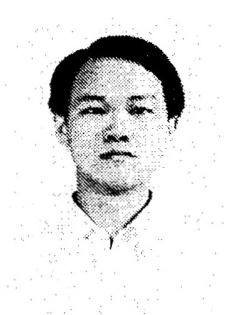
Yiming Li is currently an Associate Profe ss or with the Department of Communication Engineering and is an Adjunct Professor of the Institute of Management of Technology, National Chiao Tung University (NCTU), Hs inchu, Taiwan. He is a Deputy Director of the Modeling and Simulation Center and conducts the Parallel and Scientific Computing Laboratory at NCTU. His research areas include computational biology, electronics, and physics, bioinformatics, semiconductor device modeling, VLSI circuit simulation, optimisation, scientific computing, and computational intelligence He has authored or coauthored over 120 research papers appearing in international book chapters , journals, and conferences He has organised and served on several international conferences, and has served as a reviewer and Guest Editor for a large number of international journals. He currently serves as an Editor for several international journals. He is a member of Phi Tau Phi, Sigma Xi , APS, ACS, ACM, ESCMSE, IEEE, IEICE, Japan, and SIAM, and is included in Who's Who in the World. He was the recipient of the 2002 Research Fellowship Award presented by the Pan Wen-Yuan Foundation, Taiwan.
1 Symposium Organizer and Chair. E-mail : ymli@faculty nctu.edu.tw, ymli@mail.nctu edu.tw
Brill Academic Publishers
P.O. Box 9000, 2300 PA leiden
The Netherlands
Lecwre Se1·ies on Computer and Computational Sciences Volume 7, 2006, pp. 812-815




